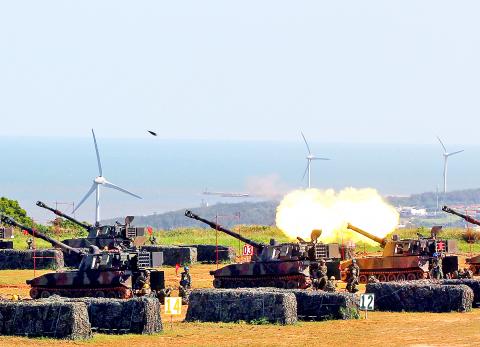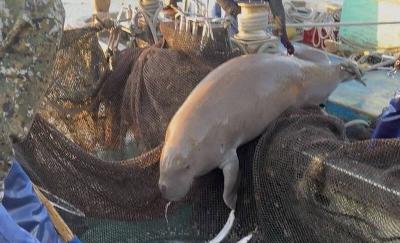Airborne operations to test the defensive capabilities of a vital air force base and a simulation of Chinese People’s Liberation Army (PLA) forces making a beach landing were the main events on the fourth day of the annual Han Kuang military exercises yesterday.
Fighter jets and C-130 Hercules transport planes dotted the sky over Cingcyuangang Air Base (清泉崗) in Taichung in the morning, with paratroopers descending from the planes in a combined combat operation with infantry forces and armored battalions to repel a simulated enemy advance on the base.
Troops delivered parachuted pallets of munitions and supplies from the C-130 planes, while the successful drop of a 2.75-tonne Humvee drew applause from observers.

Photo: CNA
The exercise was coordinated by Air Force 439 Composite Wing and Army Airborne Special Forces Command, postulating a raid by PLA airborne units to take over the base, with combat operations by troops to secure the vital airport.
Elsewhere, the simulation had a mock PLA “tank lander vessel” make an amphibious incursion onto a beach in Pingtung County’s Fangliao Township (枋寮), where “enemy” forces rolled out battle tanks, self-propelled howitzers, armored personnel carriers and trucks aiming to cut off main roads.
According to Ministry of National Defense officials, the war game in Pingtung showed that the region’s units were able to mobilize quickly in the defense of key installations while mounting countermeasures to neutralize PLA tank and armored vehicle forces before they could make significant advances inland.

Photo: CNA
Live-fire drills saw artillery bombardment on offshore target areas in the Taiwan Strait at the Kengzikou range in Hsinchu County, with President Ma Ying-jeou (馬英九) in attendance.
The drills incorporated 18 8-inch M110 self-propelled howitzers and 20 M109 self-propelled 155mm howitzers from the 6th Corps of the 21st Artillery Command joined by the 542nd Armored Brigade.
A total of 304 shells were fired during the drill to fend off ships attempting to make a landing, with a total of 800 soldiers and officers participating.
Ma said Taiwan would not let its guard down and remains committed to self-defense.
The week-long exercises combine the mobilization of army, navy and air force units to test joint operations in the face of threats from China.
A new radar system, developed by National Chung-shan Institute of Science and Technology, was deployed for the first time during the exercises.
The Point Defense Array Radar System (PODARS) was used during a drill by artillery troops and the army’s 542nd Armored Brigade, which involved medium-range and long-range shelling.
It was deployed near the artillery forces in tandem with Avenger anti-aircraft missile launchers, according to a ministry official.
The army has 14 PODARS, which cost a total of NT$6.165 billion (US$187.6 million), the official said.
The system was introduced to the public on July 4 to demonstrate national defense capabilities.
Additional reporting by CNA

‘DENIAL DEFENSE’: The US would increase its military presence with uncrewed ships, and submarines, while boosting defense in the Indo-Pacific, a Pete Hegseth memo said The US is reorienting its military strategy to focus primarily on deterring a potential Chinese invasion of Taiwan, a memo signed by US Secretary of Defense Pete Hegseth showed. The memo also called on Taiwan to increase its defense spending. The document, known as the “Interim National Defense Strategic Guidance,” was distributed this month and detailed the national defense plans of US President Donald Trump’s administration, an article in the Washington Post said on Saturday. It outlines how the US can prepare for a potential war with China and defend itself from threats in the “near abroad,” including Greenland and the Panama

A wild live dugong was found in Taiwan for the first time in 88 years, after it was accidentally caught by a fisher’s net on Tuesday in Yilan County’s Fenniaolin (粉鳥林). This is the first sighting of the species in Taiwan since 1937, having already been considered “extinct” in the country and considered as “vulnerable” by the International Union for Conservation of Nature. A fisher surnamed Chen (陳) went to Fenniaolin to collect the fish in his netting, but instead caught a 3m long, 500kg dugong. The fisher released the animal back into the wild, not realizing it was an endangered species at

The Chinese Nationalist Party (KMT) is maintaining close ties with Beijing, the Democratic Progressive Party (DPP) said yesterday, hours after a new round of Chinese military drills in the Taiwan Strait began. Political parties in a democracy have a responsibility to be loyal to the nation and defend its sovereignty, DPP spokesman Justin Wu (吳崢) told a news conference in Taipei. His comments came hours after Beijing announced via Chinese state media that the Chinese People’s Liberation Army’s Eastern Theater Command was holding large-scale drills simulating a multi-pronged attack on Taiwan. Contrary to the KMT’s claims that it is staunchly anti-communist, KMT Deputy

The High Prosecutors’ Office yesterday withdrew an appeal against the acquittal of a former bank manager 22 years after his death, marking Taiwan’s first instance of prosecutors rendering posthumous justice to a wrongfully convicted defendant. Chu Ching-en (諸慶恩) — formerly a manager at the Taipei branch of BNP Paribas — was in 1999 accused by Weng Mao-chung (翁茂鍾), then-president of Chia Her Industrial Co, of forging a request for a fixed deposit of US$10 million by I-Hwa Industrial Co, a subsidiary of Chia Her, which was used as collateral. Chu was ruled not guilty in the first trial, but was found guilty